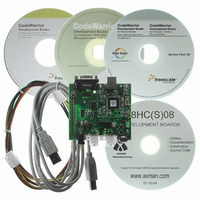DEMO9S08EL32 Freescale Semiconductor, DEMO9S08EL32 Datasheet - Page 28

DEMO9S08EL32
Manufacturer Part Number
DEMO9S08EL32
Description
BOARD DEMO FOR 9S08 EL MCU
Manufacturer
Freescale Semiconductor
Type
MCUr
Datasheets
1.DEMO9S08EL32.pdf
(356 pages)
2.DEMO9S08EL32.pdf
(14 pages)
3.DEMO9S08EL32.pdf
(2 pages)
Specifications of DEMO9S08EL32
Contents
Evaluation Board
Processor To Be Evaluated
MC9S08EL32
Data Bus Width
8 bit
Interface Type
RS-232, USB
Operating Supply Voltage
12 V
Silicon Manufacturer
Freescale
Core Architecture
HCS08
Core Sub-architecture
HCS08
Silicon Core Number
MC9S08
Silicon Family Name
S08EL
Rohs Compliant
Yes
For Use With/related Products
MC9S08EL32
Lead Free Status / RoHS Status
Lead free / RoHS Compliant
- Current page: 28 of 356
- Download datasheet (9Mb)
Chapter 2 Pins and Connections
2.2.4
While in reset, the BKGD/MS pin functions as a mode select pin. Immediately after reset rises, the pin
functions as the background pin and can be used for background debug communication. While functioning
as a background or mode select pin, the pin includes an internal pull-up device, input hysteresis, a standard
output driver, and no output slew rate control.
If nothing is connected to this pin, the MCU will enter normal operating mode at the rising edge of reset.
If a debug system is connected to the 6-pin standard background debug header, it can hold BKGD low
during the rising edge of reset which forces the MCU to active background mode.
The BKGD/MS pin is used primarily for background debug controller (BDC) communications using a
custom protocol that uses 16 clock cycles of the target MCU’s BDC clock per bit time. The target MCU’s
BDC clock could be as fast as the bus clock rate, so there should never be any significant capacitance
connected to the BKGD/MS pin that could interfere with background serial communications.
Although the BKGD/MS pin is a pseudo open-drain pin, the background debug communication protocol
provides brief, actively driven, high speedup pulses to ensure fast rise times. Small capacitances from
cables and the absolute value of the internal pull-up device play almost no role in determining rise and fall
times on the BKGD/MS pin.
2.2.5
The MC9S08EL32 Series and MC9S08SL16 Series of MCUs support up to 22 general-purpose I/O pins
which are shared with on-chip peripheral functions (timers, serial I/O, ADC, etc.).
When a port pin is configured as a general-purpose output or a peripheral uses the port pin as an output,
software can select one of two drive strengths and enable or disable slew rate control. When a port pin is
configured as a general-purpose input or a peripheral uses the port pin as an input, software can enable a
pull-up device. Immediately after reset, all of these pins are configured as high-impedance
general-purpose inputs with internal pull-up devices disabled.
When an on-chip peripheral system is controlling a pin, data direction control bits still determine what is
read from port data registers even though the peripheral module controls the pin direction by controlling
the enable for the pin’s output buffer. For information about controlling these pins as general-purpose I/O
pins, see
28
Chapter 6, “Parallel Input/Output
Background / Mode Select (BKGD/MS)
General-Purpose I/O and Peripheral Ports
In EMC-sensitive applications, use an external RC filter on RESET. See
Figure 2-3
To avoid extra current drain from floating input pins, the reset initialization
routine in the application program should either enable on-chip pull-up
devices or change the direction of unused or non-bonded pins to outputs so
they do not float.
MC9S08EL32 Series and MC9S08SL16 Series Data Sheet, Rev. 3
for an example.
Control.”
NOTE
NOTE
Freescale Semiconductor
Related parts for DEMO9S08EL32
Image
Part Number
Description
Manufacturer
Datasheet
Request
R
Part Number:
Description:
Manufacturer:
Freescale Semiconductor, Inc
Datasheet:
Part Number:
Description:
Manufacturer:
Freescale Semiconductor, Inc
Datasheet:
Part Number:
Description:
Manufacturer:
Freescale Semiconductor, Inc
Datasheet:
Part Number:
Description:
Manufacturer:
Freescale Semiconductor, Inc
Datasheet:
Part Number:
Description:
Manufacturer:
Freescale Semiconductor, Inc
Datasheet:
Part Number:
Description:
Manufacturer:
Freescale Semiconductor, Inc
Datasheet:
Part Number:
Description:
Manufacturer:
Freescale Semiconductor, Inc
Datasheet:
Part Number:
Description:
Manufacturer:
Freescale Semiconductor, Inc
Datasheet:
Part Number:
Description:
Manufacturer:
Freescale Semiconductor, Inc
Datasheet:
Part Number:
Description:
Manufacturer:
Freescale Semiconductor, Inc
Datasheet:
Part Number:
Description:
Manufacturer:
Freescale Semiconductor, Inc
Datasheet:
Part Number:
Description:
Manufacturer:
Freescale Semiconductor, Inc
Datasheet:
Part Number:
Description:
Manufacturer:
Freescale Semiconductor, Inc
Datasheet:
Part Number:
Description:
Manufacturer:
Freescale Semiconductor, Inc
Datasheet:
Part Number:
Description:
Manufacturer:
Freescale Semiconductor, Inc
Datasheet:










